Print-on-demand (POD) has become an increasingly popular business model for entrepreneurs and creators looking to sell custom products without holding inventory. In 2025, the POD industry is thriving – driven by consumer demand for unique, personalized items and the low-risk, low-investment nature of this model. In fact, the global print-on-demand market (especially in apparel) continues to grow at a healthy pace, with estimates projecting it to reach $161.85 billion by 2032 (a ~10.9% annual growth). This means there’s huge opportunity for new and established online sellers to capitalize on POD.
We’ll explore what print-on-demand companies are and how the POD process works, discuss how to choose the best POD supplier for your needs, and highlight 15 of the best print-on-demand companies in 2025. We’ll also answer which POD products offer the highest profit margins, recommend the top print-on-demand app for Shopify, and wrap up with a quick FAQ. Whether you’re a startup founder or an established retailer wanting to expand your product line, this guide will provide professional yet accessible insights to help you succeed with print-on-demand. Let’s dive in!
What Is a Print-on-Demand Company?
A print-on-demand company is a third-party service that prints, packs, and ships products on behalf of a seller only after an order is placed. In other words, the product is not made until someone actually buys it – hence “on-demand.” This allows you (the seller) to offer a wide variety of custom-designed products without ever stocking inventory or investing in bulk upfront. The POD provider handles all the production and logistics behind the scenes, while you focus on creating designs and marketing your online store. Once a customer orders an item from your store, the POD company prints your design on the chosen product, packages it, and ships it directly to the customer – you then earn the profit margin (your retail price minus the base cost and shipping fee).
In essence, a print-on-demand company functions as your silent fulfillment partner. You upload designs (for t-shirts, mugs, books, art prints, etc.), set your prices, and the POD service takes care of manufacturing each item to order and delivering it. This model lets anyone run an ecommerce shop without the typical headaches of inventory management, upfront costs, or shipping logistics. It’s a form of dropshipping specifically for custom products – sometimes you’ll hear POD and dropshipping used together because the POD provider “dropships” the product to your customer on your behalf.
Key benefits of this model include zero inventory risk, low startup cost, and the freedom to experiment with many designs or niches. You don’t pay for a product until it’s sold, and you’re not stuck with unsold stock. It’s easy to scale up or pivot to new product ideas since you’re not tied down by large bulk orders. Many artists, designers, and entrepreneurs embrace POD as a lean way to launch a brand or test products, because you can run an entire online business without ever touching the merchandise.
Examples: Popular print-on-demand products include custom T-shirts, hoodies, tote bags, coffee mugs, phone cases, wall art, books, stickers, and more. For instance, if you design a graphic tee and list it for sale, your chosen POD supplier will print that design onto a shirt only when someone orders it, then ship it out. If nobody orders that design, you haven’t lost money printing a batch of shirts – you can simply try a new design. This flexibility and reduced risk make POD very appealing, especially for small businesses and creators.
How Does Print-on-Demand(POD) Work?
At first glance, print-on-demand might sound like magic – a way to “make money while you sleep.” In reality, it’s a streamlined fulfillment process enabled by today’s technology and global supplier networks. Here’s a step-by-step breakdown of how the print-on-demand process works:
-
Choose a POD Platform or Supplier: To get started, you sign up with a print-on-demand service provider. This could be a platform like Printful, Printify, Gelato, CJdropshipping, etc. – we’ll review the top options later. Pick a provider that fits your needs in terms of product catalog, quality, shipping locations, and integration with your selling platform. This company will be your fulfillment partner, so research carefully.
-
Create Your Designs: Next, you create the artwork or design that will be printed on products. You don’t need to be a pro designer – many POD platforms have built-in design tools or you can use graphic software (Adobe Illustrator, Canva, etc.). The design could be a logo, illustration, slogan, photograph – whatever you envision for your merchandise.
-
Add Products to Your Store: Using the POD provider’s app or interface, you select which products to apply your designs to (e.g. a black t-shirt, a ceramic mug, a canvas print). You upload the design file and generate product mockups. Then you publish these product listings to your online store or marketplace with your set retail prices. At this stage, the products exist virtually in your store, but none are made yet.
-
Customer Places an Order: When a customer visits your ecommerce store and buys a product, the order details (product, size, design, customer address, etc.) are automatically sent to your print-on-demand supplier. This is usually handled seamlessly via an integration or app. You collect the payment from the customer (say, $30 for a custom hoodie).
-
Production & Fulfillment by POD Provider: Once the order is received, your POD partner springs into action. They will print your design onto the selected product using the appropriate method (direct-to-garment printing, sublimation, engraving, etc. depending on the item). After printing, they package the product (often in unbranded or your-branded packaging) and ship it directly to your customer. You don’t have to do a thing here – the POD company handles printing, quality control, packing, and shipping logistics.
-
You Pay the Base Cost: For each order, the POD provider charges you the base cost of the product + fulfillment (for example, $15 for printing and shipping that hoodie). This is typically automatically deducted or charged to your account on the platform. The difference between what the customer paid and this base cost is your profit. (Using the example: customer paid $30, POD charged you $15 total, so $15 profit remains for you.)
-
Customer Receives the Product: The end customer gets the package with the custom item they ordered, usually without ever knowing a third-party fulfilled it. From their perspective, it’s your brand’s product. You didn’t have to touch any inventory or run to the post office – it was all handled behind the scenes.
This entire process can happen quite fast. Many POD companies print and ship within a few days of order. For instance, CJdropshipping reports that 50% of their orders are ready to ship in under 3 days. With global fulfillment centers, often the order is routed to a printer closest to the customer to reduce shipping time. The result: your customer receives a made-to-order product in a timeframe comparable to regular retail shipping, and you successfully deliver on-demand merchandise with minimal overhead.
Why does this model matter? It democratizes product selling. As Shopify describes, print-on-demand “eliminates the need to purchase and manage inventory,” allowing entrepreneurs to test products without big financial risk. You can offer a wide catalog of designs and products (from apparel to home decor to books) under your brand, and only pay for what actually sells. This has opened the door for countless small businesses, artists, and even influencers to monetize their creativity through custom merchandise – from YouTubers selling branded hoodies to artists selling prints and authors printing books on demand.
Of course, POD isn’t a get-rich-quick scheme; it requires smart marketing, quality designs, and choosing the right partner. But it’s a proven model in 2025 for running a lean, scalable online store. Next, we’ll discuss how to choose the best print-on-demand company for your needs, since that decision is crucial.
How to Choose the Best Print on Demand(POD) Company
Not all print-on-demand providers are created equal. There are dozens of POD companies out there, each with different specialties, pricing, and features. Choosing the right one can make a big difference in your store’s success – affecting your profits, customer satisfaction, and ease of operation. Here are key factors and criteria to consider when evaluating print-on-demand companies:
-
Product Quality & Variety: Look at the types of products the supplier offers and the quality of those items. Do they have the categories you want to sell (e.g. apparel, accessories, home decor, books)? Are the base products high-quality (fabric, material, durability)? Offering premium, well-made products will satisfy customers and reduce returns. For example, if you plan to sell shirts, you’ll want a POD provider with a range of sizes, fabric options (cotton, blends), and maybe well-known brands of blank shirts. Read reviews or order samples to assess quality.
-
Pricing (Base Costs) and Profit Margins: Compare the base prices that POD services charge for products and printing, as well as their shipping rates. This directly impacts your profit. A supplier might have cheaper t-shirt costs but higher shipping, or vice versa. Consider the total cost per item delivered. Also note if they offer volume discounts or premium plans for lower costs. The goal is to find a provider that allows you to price your products competitively while still making a profit. Don’t forget to factor in any monthly fees (most POD apps are free to start, though some have paid tiers for discounts).
-
Shipping Speed and Locations: Fast and reliable shipping is vital for customer satisfaction. Check where the company’s fulfillment centers are located and their typical production + delivery times. If your customers are in the US, a supplier with US-based printing will likely get orders delivered faster (and cheaper) than one shipping everything from overseas. Many top POD companies have multiple global print partners (US, EU, Asia, etc.) to facilitate localized fulfillment. Look for stated average turnaround times – e.g. 2-5 day fulfillment, plus shipping time. Also consider if tracking is provided and how they handle international shipping.
-
Integration with Your Store Platform: Ideally, the POD service offers a direct integration or app for the ecommerce platform you use (Shopify, WooCommerce, Etsy, etc.). This makes the workflow seamless – orders will sync automatically and tracking can be sent to your store/consumer without manual input. The easier the integration, the less time you spend on admin. Most major POD providers have a Shopify app and support other platforms via plugins or API. Double-check that the one you choose plays nicely with your website.
-
Customization and Branding Options: Beyond just printing a design, some companies offer extra customization that can elevate your brand. This might include inside labels or neck tags on clothing, branded pack-ins or custom packaging, logo stickers on the box, or a personalized note. These touches can improve the unboxing experience and reinforce your brand identity. Not all POD suppliers allow this, or some charge extra for branding services. If building a brand is important to you, look for providers with white-label shipping (no supplier logos) and options for custom branding.
-
Customer Service and Support: When something goes wrong (e.g. a misprint, lost package, tech glitch), you’ll want a supplier that is responsive and helpful. Check reviews for feedback on their support. Do they offer 24/7 support, live chat, or a dedicated account manager for sellers? A POD partner with excellent customer service can save you headaches in the long run. Also, clear policies for issues like reprints for damaged goods or handling returns are part of support.
-
Supplier Location & Reliability: Consider where the company is based and how long they’ve been in business. Established providers in your target market may be more reliable. If a supplier is based in China, for example, they might have very low costs but potentially longer shipping times to the US (unless they have local warehouses). On the other hand, a US-based provider might deliver fast domestically but have higher base prices. Weigh the trade-offs in context of your audience.
-
Return Policy: With POD, typically products are custom-made, which complicates returns. Many POD services will only accept returns or replacements if there’s a printing error or product defect, not for buyer’s remorse or sizing issues (since the item was made specifically for that order). Understand your supplier’s return/remake policy and warranty. Ideally, they should stand behind the quality (reprint or refund if there’s a mistake on their end). You as the store owner will likely handle customer-facing returns, but it helps to know if the supplier will absorb the cost of misprints, etc., or if you’ll be on your own.
In short, evaluate each POD company holistically. The best choice depends on your specific needs – if ultra-fast shipping is your priority, you might choose one with local production. If widest product range is key, another might suit you better. If you want to sell in Europe, a Europe-based printer could be ideal. Take time to read comparisons and maybe test a few. As one guide summarizes, “Choose a print-on-demand platform by evaluating its product quality, shipping times, pricing structure, return policy, and integration with your ecommerce store. Look for suppliers offering customization options, strong customer service, and fulfillment centers near your customers.”. If you cover those bases, you’ll set yourself (and your customers) up for success.
Now, let’s look at some of the best print-on-demand companies in 2025 and what each offers. The list below includes a mix of well-known global POD providers and niche/specialized services – each with its own strengths. We’ll also make sure to highlight CJdropshipping, a platform that has expanded into POD and offers unique advantages as an all-in-one solution.
15 Best Print-on-Demand Companies for 2025
Choosing the right POD supplier can be daunting, so we’ve compiled 15 of the top print-on-demand companies (and platforms) that stand out in 2025. This list covers providers known for quality, range of products, reliable integrations, and positive user feedback. No matter if you’re a beginner or scaling up your POD business, these companies are worth considering. (Note: All of these services can integrate with online stores or offer a platform to sell; many are available as Shopify apps for easy setup.)
1. CJdropshipping – Best All-in-One Dropshipping + POD Solution

CJdropshipping is a bit different from others on this list – it’s not exclusively a print-on-demand company, but rather a comprehensive dropshipping platform that also offers robust POD services. CJdropshipping (often simply called “CJ”) has emerged as a leading partner for Shopify sellers by combining product sourcing, global warehouses, and print-on-demand under one roof. If you want a one-stop solution for both custom products and regular dropship products, CJ is a compelling choice.
Overview of CJdropshipping: CJ started in China as a sourcing agent and dropship fulfillment center, providing a vast catalog of products (much like AliExpress, but with more hands-on service and faster shipping lines). In recent years, CJ added a dedicated Print on Demand feature called “CJ POD” – accessible right from their site/app. They now have hundreds of print-on-demand products including T-shirts, hoodies, mugs, jewelry, home decor, phone cases, and more. The unique aspect is you can also source non-POD items (electronics, toys, beauty products, etc.) from CJ’s marketplace and sell them alongside your POD items, with CJ fulfilling everything together.
CJ’s POD Advantages:
-
Massive Product Range: CJdropshipping offers over 400,000 SKUs in total on their platform, with a mix of POD and non-POD. For POD specifically, they might have slightly fewer options than a pure POD like Printify’s 1300 products, but they cover all the popular categories and even some unique ones (like print on demand music boxes or lamps). If something isn’t listed, CJ can often source a product for you and enable it for POD printing – a service not available elsewhere.
-
Global Warehouses & Fast Shipping: CJ has warehouses in the US (multiple), Europe, and Asia. They stock inventory for popular items and also can pre-stock your bestsellers (even POD ones after they’re produced) in domestic warehouses. They operate their own shipping lines (CJPacket) that dramatically speed up shipping from China to the world, often delivering to the US in about 7-12 days, or even faster via local stock. With US warehouses, delivery can be 3-6 days to US customers – essentially on par with domestic POD providers. This addresses one traditional weakness of China-based suppliers (long shipping) quite well.
-
No Upfront Fees & Low Costs: CJdropshipping is free to use – no subscription, no listing fees. Their product costs are usually very competitive, often lower base cost than Western POD providers (though you may pay a bit in shipping). This can lead to higher margins. For example, a custom necklace might cost considerably less on CJ than via a US POD company, because CJ works directly with factories.
-
Integration and Automation: CJ has an official Shopify app, and it integrates with WooCommerce, eBay, Etsy and more. When an order comes in, they will automatically process it. Their system can bundle multiple products in one order (even if a customer orders a POD t-shirt and a non-POD gadget together, CJ can ship them in one package if from the same warehouse). They also provide features like automatic order syncing, tracking updates, and even print-on-demand design templates on their site.
CJdropshipping POD Process: You can use their design interface to upload your artwork onto products (for some items, they even allow custom engraving or customer-uploaded images as options). They then print and fulfill like any POD. CJ describes their service as “You Sell, We Print” – encapsulating how you focus on selling, while they handle production. They support private labeling in some cases – e.g., adding your logo to packaging or using your branded inserts, since they offer custom packaging services too.
Why Choose CJdropshipping: The key reason is the all-in-one convenience and scalability. By using CJ, you can manage both your POD products and any other dropship products from a single dashboard, with one supplier relationship. For a seller, that means fewer apps and easier logistics. CJ’s massive catalog also means you could rapidly expand your store offerings (say you design a cool mug on POD – you could also find a complementary non-POD item to upsell, all from CJ). Additionally, CJ’s global fulfillment network ensures that as you grow, you can serve international customers efficiently (they serve 60+ countries and have local warehouses to reduce shipping times). They truly offer warehouse services, sourcing, and POD printing together – a unique combo.
CJdropshipping is especially valuable for startup brands on a budget – you pay nothing upfront, and their prices are favorable. Imagine launching a store where half your products are custom printed and half are trending gadgets: CJ can handle both, and even put your logo on the outgoing package. Many users highlight that CJ’s support is quite attentive, offering personal agent assistance to source or resolve issues.
Of course, CJ being based in China means you should always test product quality and be mindful of sizing (for apparel) etc., but they have improved quality control with inspection services and pretty strict vetting of their product listings. They even mention a quality control service where they inspect items before shipping for an extra layer of assurance.
In summary, CJdropshipping stands out as the best print-on-demand solution for those who want flexibility to sell almost anything without inventory, while still enjoying strong POD capabilities. It’s like having the breadth of AliExpress with the customization of Printful, combined in a seller-friendly platform. For 2025 and beyond, CJdropshipping is definitely a platform to consider, particularly if you plan to scale and diversify your product range (and it’s one of the reasons we included it on this list – its advantages can genuinely help merchants grow).
2. Printify – Best Supplier Network & Variety
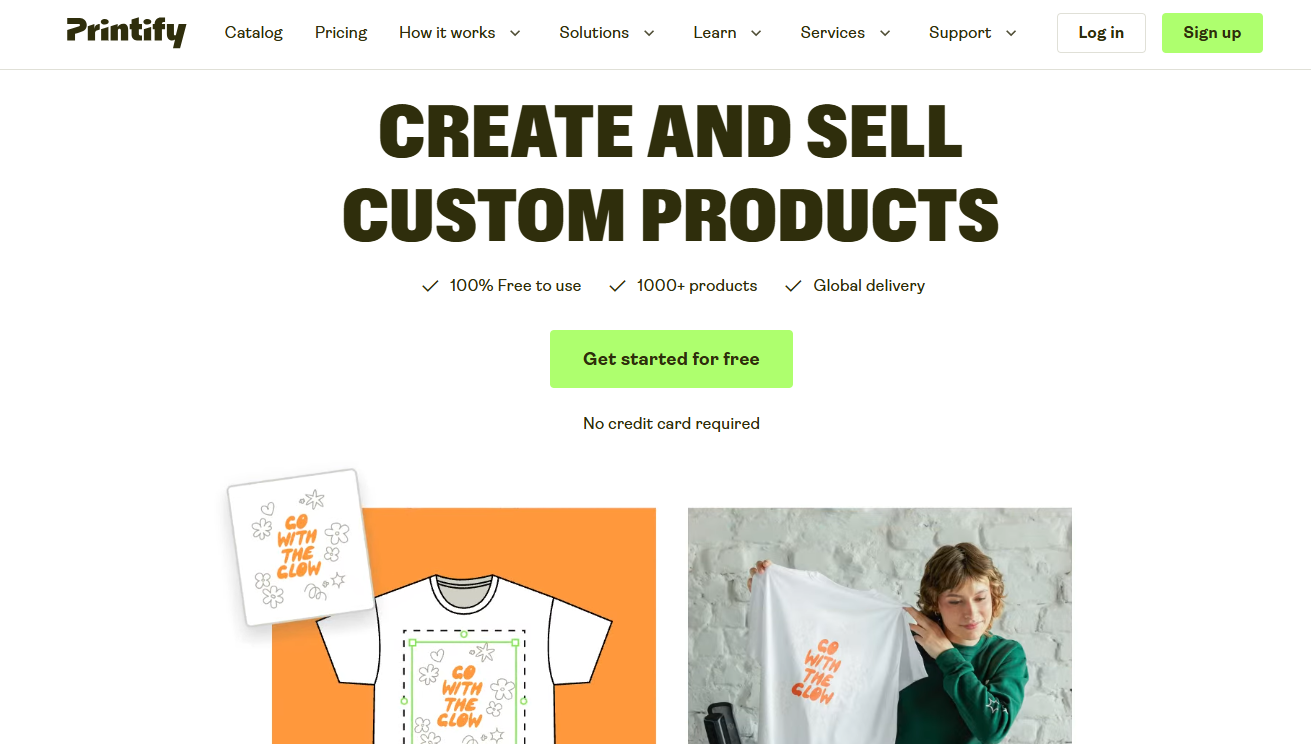
Printify takes a different approach: it’s a platform that connects you to a network of print providers worldwide rather than printing in-house. Through Printify, you can access 100+ print partners offering over 1,300 customizable products – one of the largest selections in the industry. If you want a huge variety (including some unique items), Printify shines. For instance, beyond the usual shirts and mugs, you’ll find things like shoes, skirts, clocks, jewelry boxes, and more, depending on the print provider. You also often have multiple supplier options for a given product, which you can choose based on location or price.
Key Features: Printify’s model lets you select a provider in the USA, Europe, etc., for each product to optimize shipping for your customers. Their interface will show you the base cost and shipping from each print partner so you can compare. They support all major print methods (DTG, sublimation, embroidery, etc.) through various partners. Printify itself is free to use, but they offer a Premium plan ($29/month) that gives you 20% off all orders – many sellers use this to significantly increase their margins if volume justifies it.
Integration: Printify integrates with Shopify, Etsy, WooCommerce, and more, similar to Printful. Orders flow through automatically to whichever print provider you’ve chosen. One appreciated aspect: Printify provides real-time shipping updates and transparent pricing, helping store owners manage orders efficiently. They also have a robust catalog search and design generator.
Printify Pros & Cons: The biggest pro is product variety and cost flexibility – you can often find slightly lower base prices by choosing a print partner in a region with cheaper production, or offer products not found elsewhere. Sellers often commend Printify’s ease of use and the ability to source locally (e.g., use a UK printer for UK orders to speed up shipping). In Shopify’s app store, Printify is rated 4.7 out of 5 with over 2,400 reviews, noted for being easy to navigate even for beginners. The main con is variable quality – since quality depends on the third-party provider, it can be inconsistent. One print shop might have excellent quality and another mediocre. However, Printify does vet providers and has a “Printify Choice” badge for top performers. As a seller, you should order samples from the providers you plan to use. In summary, choose Printify if you want lots of options and competitive pricing and are willing to manage the selection of print vendors to maintain quality.
3. CustomCat – Best for Fast US Shipping

CustomCat is a Detroit-based print-on-demand company known for its lightning-fast production and fulfillment, especially for U.S. orders. They boast industry-leading turnaround times – often printing and shipping within 2 business days for domestic orders. If quick delivery to customers (like Amazon Prime speed) is a top priority, CustomCat is a great choice.
Catalog & Features: CustomCat offers around 500+ products, focusing heavily on apparel (tons of t-shirt styles, sportswear, hats) and some home goods (mugs, blankets, etc.). They are known for a few unique offerings like all-over-print (AOP) sportswear, jerseys, and a wide range of embroidered items. CustomCat’s base prices are quite competitive – they run their own production facility which helps keep costs down. There is a $30/month premium membership option that lowers prices even further, but it’s optional. CustomCat integrates with Shopify (they have an app), WooCommerce, Etsy and more for automatic order syncing.
Speed Advantage: The big selling point is speed. CustomCat’s facility in Michigan fulfills many orders in 1-3 days, and since they’re centrally located in the U.S., shipping is quick nationwide. Many sellers report their customers receiving items in under a week from order date, which is excellent for POD. According to one source, CustomCat prides itself on 2-3 day US fulfillment on average. They also carry some inventory of popular blanks to facilitate rapid printing.
Why Use CustomCat: If your target market is primarily the USA and you want to minimize wait times, CustomCat is arguably one of the best. They might not have the absolute largest product range, but they cover all the core apparel and gift items most sellers need. Quality is generally good (they’ve been in business for years as a fulfillment company before launching their app). Support is decent, though not 24/7. Another perk: they support CSV order file uploads, so even if you make sales off-platform you can fulfill through CustomCat easily. Overall, CustomCat is ideal for sellers who value speed and reliability in the U.S. market, for example, if you’re doing time-sensitive merch drops or just want happy customers who get their orders quickly.
4. Gelato – Best for Global Reach & Local Printing

Gelato is a print-on-demand network that emphasizes global fulfillment and localization. The name “Gelato” hints at their origin (headquartered in Norway), but what sets them apart is having 100+ production partners in 30 countries. This means when an order comes in, Gelato will route it to a printer closest to your customer almost anywhere in the world – reducing shipping distances, costs, and delivery times. If you plan to sell internationally (e.g., have customers in North America, Europe, Asia, etc.), Gelato is a powerful option.
Products: Gelato started with a focus on printed materials like wall art, posters, photo canvases, cards, and stationery (they shine in those categories) They have since expanded into apparel, mugs, phone cases, and more – though their apparel selection may not be as huge as Printful/Printify, it’s growing. One of their specialties is custom stationery and wall art – they even market themselves as great for artists, photographers, and creators of paper products. The quality of prints is high, owing to their professional print network.
Eco-Friendly and Integrations: Gelato positions itself as a sustainable choice – by printing locally, they cut down on carbon emissions from shipping. They also often use regional print partners that follow local environmental standards. Gelato integrates with Shopify and other platforms via app; their system is straightforward to use. They offer an API as well. A neat feature: Gelato provides connections to marketplaces like Etsy, and even TikTok shopping integration, which is relatively unique.
Advantages: The biggest advantage is that customers in, say, Germany can get their order printed in Germany, customers in Australia get theirs printed in Australia, etc. This results in faster delivery and often tracking with local carriers. It also means you don’t have to manually choose providers per country – Gelato’s system handles it. They currently have print labs in over 32 countries (including all major markets in Europe, US, Canada, Brazil, India, China, Japan, Australia, and more). Another advantage is transparent pricing; they show the price inclusive of local production.
Why Choose Gelato: If your store has a global audience, Gelato can offer a superior experience by fulfilling orders regionally. Sellers who use Gelato appreciate that customers in Europe get their orders really fast (no customs delays) and at lower shipping rates. Gelato’s customer support is also well-reviewed. On the flip side, Gelato’s product range, while broad, might not have as many apparel styles as some competitors, focusing more on printable substrates (posters, cards, shirts, cases). But for many, they cover the main bases. Additionally, Gelato has no upfront fees; they do have a Plus subscription if you want discounted pricing and other benefits. All in all, Gelato is a top pick for reaching a worldwide market efficiently, combining a quality print network with an emphasis on sustainability and integration options.
5. SPOD (Spreadshop/Spreadconnect) – Best for Speedy Production
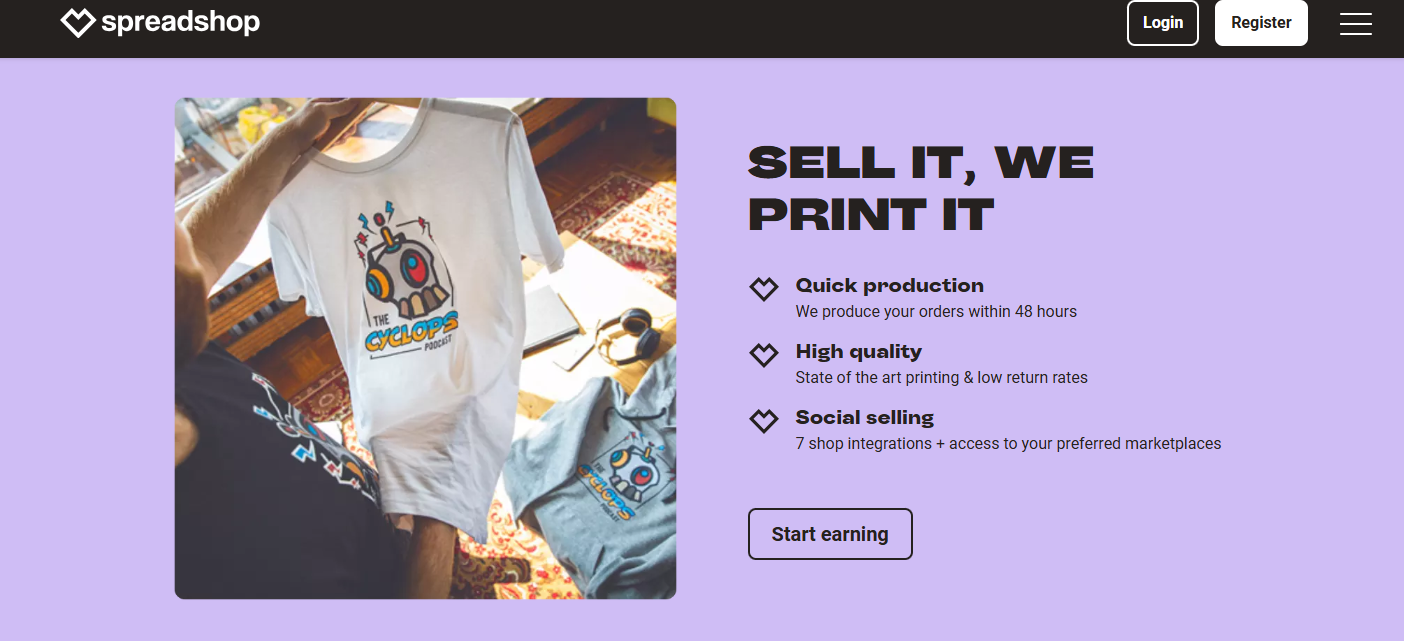
SPOD is the print-on-demand arm of Spreadshirt (a veteran in the custom printing space). In Shopify’s 2025 list they refer to it as Spreadconnect (Previously SPOD), but it’s essentially the same service. SPOD is renowned for its incredibly fast production – often 48 hours or less. According to the company, they print 95% of orders within 48 hours, which can lead to some of the fastest turnaround in the industry.
About SPOD: Backed by Spreadshirt (a popular custom merch marketplace), SPOD brings years of fulfillment experience. They have production facilities in the USA (Nevada & Pennsylvania) and Europe (Germany) to serve key markets quickly. SPOD’s catalog includes around 200+ items: lots of apparel basics (including organic options), drinkware, accessories like bags, aprons, and more. They may not have the depth of some larger catalogs, but they cover the usual products a merch seller would need.
Unique Features: SPOD offers a customization tool that you can enable for your store, allowing customers to actually personalize products themselves (upload an image or add text) on the front-end. This is great if you want to offer, say, custom text T-shirts or photo gifts without creating every variant yourself. They also provide some stock design graphics that your customers could choose from. This customer-facing customizer sets SPOD apart in giving a more interactive experience.
Why SPOD: The primary reason to use SPOD is speed and reliability. If you promise customers quick delivery, SPOD can help meet those expectations. Their integration with Shopify (via the SPOD app) is smooth, and they focus on efficiency. Base prices are reasonable and they often run promotions on sample orders. The service is pretty no-frills – you might not get advanced branding options, but you do get dependable fulfillment. For sellers in Europe, SPOD is quite popular due to the German production (fast shipping across EU). If minimal production time is your goal, SPOD is among the best. In the “best of 2025” ranking, it was highlighted for “fast 2-day production, multiple print methods, and user-friendly tools”.
6. Gooten – Great for Home Goods & Flexibility

Gooten is a print-on-demand network/platform similar to Printify in that they connect to various manufacturing partners. Gooten stands out for a strong selection of home decor and lifestyle products, and a focus on business-friendly features (like volume order handling, an API, etc.). Many merchants appreciate Gooten for its reliability at scale and the breadth of product categories.
Product Range: Gooten offers 150+ products including standard apparel and mugs, but also lots of homeware (pillows, throws, coasters, aprons, napkins, wall art), pet products, and some unique items like puzzles and yoga mats. If your niche is beyond just t-shirts (e.g., you run a home decor shop), Gooten likely has what you need – hence Shopify called it “Best for custom homeware.”.
Quality and Network: Gooten has a vetted network of global manufacturers. They automatically route orders to the best manufacturer based on customer location and other factors. Their quality control is generally good, as they continuously monitor partner performance. Gooten tends to be used by more established businesses and dropshippers as well; they tout enterprise-level solutions for high order volumes.
Features: The Gooten dashboard allows easy product creation and integration with Shopify, WooCommerce, and others. They also have an API for custom integrations. One notable feature is their order routing logic – you don’t have to pick a specific print provider, Gooten handles fulfillment assignment, aiming for optimal delivery. Gooten is free to use, with no subscription fees.
Why Use Gooten: If you want a wide variety of products (especially in home and lifestyle niches) and a partner that can handle large scale orders reliably, Gooten is a strong candidate. They have been praised for good customer support and a proactive approach to solving issues. While perhaps not as famous as Printful, Gooten has quietly powered many successful POD stores. It’s particularly good if your brand will sell things like throw pillows with designs, kitchenware, etc., in addition to apparel. With production partners in North America, Europe, and beyond, Gooten can fulfill globally, though shipping times will depend on the product and routing. All in all, Gooten is a flexible, broad POD solution with an edge in home goods and an emphasis on efficient fulfillment.
7. Apliiq – Best for Custom Clothing & Private Label
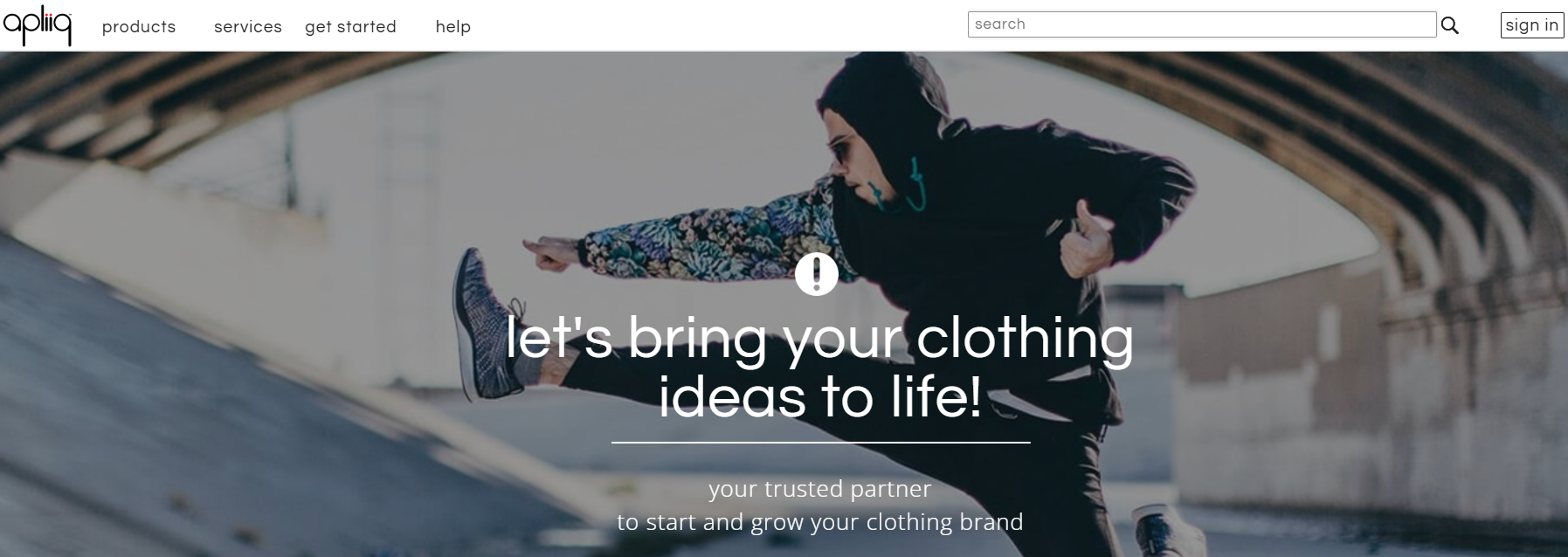
Apliiq is a Los Angeles-based POD provider that specializes in fashion-forward apparel and private label services. If you’re looking to build your own clothing line with more control over branding (like relabeling garments, cut-and-sew products, etc.), Apliiq is one of the best options. Shopify’s list crowned Apliiq “Best for custom clothing”.
What Apliiq Offers: Unlike most POD companies that print on standard wholesale blanks, Apliiq allows you to truly private label your apparel. They can remove the manufacturer’s tags and sew in your custom neck labels, add hem tags, and offer unique options like embroidery, cut-and-sew patches, and applique designs. This is great for streetwear brands or anyone who wants their apparel to have a retail-quality finish. Apliiq’s product catalog is mostly clothing – t-shirts, hoodies, joggers, jackets, etc., including premium brands (they source blanks from brands like American Apparel, Next Level, Bella+Canvas) as well as some unique items like reversible sequin shirts.
Quality & Pricing: Apliiq is all about quality and customization, so their base prices are higher than average. However, you’re paying for those extra services and higher-end garments. For example, getting a custom woven label sewn in will add a cost but immensely elevate your brand perception. They have a VIP program for lower costs at volume. Apliiq produces items in their LA facility (and partner facilities) and does quality checks on each.
Integration: They integrate with Shopify via an app. The product setup is a bit more involved since you can choose many customization options. But they have support to guide you through making your products truly “yours.”
Why Choose Apliiq: If your goal is to create a premium apparel brand through POD, Apliiq is hard to beat. They allow a level of brand customization (labels, etc.) that most print-on-demand providers don’t. It’s essentially a bridge between traditional clothing manufacturing and on-demand – you get on-demand printing plus bespoke brand finishing. Many streetwear and fashion Shopify stores use Apliiq to produce their clothing lines without investing in inventory. Just note that Apliiq may not be the best for non-apparel products (they are very apparel-centric) and not ideal if you just want the cheapest shirts possible. It’s for when you’re willing to invest a bit more per unit to create a branded clothing experience for your customers.
8. TeeLaunch – Best for Unique and Novelty Products
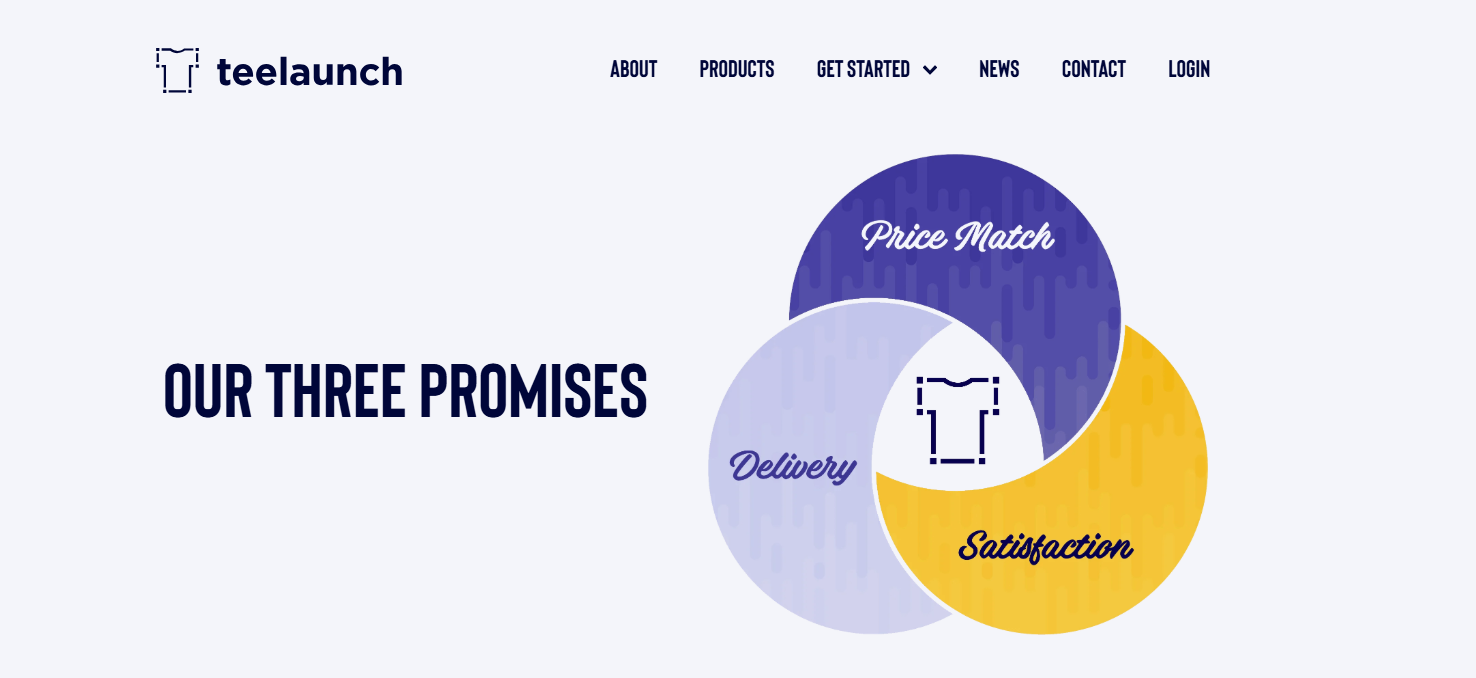
TeeLaunch is a long-standing POD app for Shopify (one of the early ones in fact) known for offering a variety of unique products that go beyond the usual fare. They’re an agile company that often adds new interesting items. In 2025, Shopify highlighted TeeLaunch as “Best for unique products.”
Product Highlights: TeeLaunch has all the common products (shirts, hoodies, mugs, posters) but also a good number of niche items. For example: Bluetooth speakers, wireless chargers, barware (custom engraved whiskey stones or flasks), kitchenware (cutting boards, plates), pet supplies (pet bowls, tags), and even car accessories. They continue to expand into novel categories. This makes TeeLaunch a fun choice if you want to differentiate your store with products other POD services may not carry.
Quality & Production: TeeLaunch works with various manufacturing partners (for instance, electronics might be sourced differently than printed shirts). They have facilities in the US for many items. Quality tends to be solid, and they have good engraving and printing capabilities for those specialty items. Base prices are generally competitive. TeeLaunch doesn’t charge monthly fees; it’s pay-per-product.
Integration: It started as a Shopify app and remains one of the straightforward ones – easy to create products and push to your store. They also integrate with Etsy now via a tool. Their interface is not the fanciest, but it gets the job done.
Why Use TeeLaunch: Use TeeLaunch if you want to expand your product range creatively. For example, if you’re doing a branded store, you might start with shirts on Printful but then use TeeLaunch to add custom engraved tumblers, or printed fleece blankets, etc., to increase your average order value or unique catalog. Many sellers use multiple POD apps in tandem, and TeeLaunch often fills that “interesting extras” role. Their support is responsive, and they’ve been around a while, which gives some confidence in stability. All in all, TeeLaunch is best for complementing your core products with cool, quirky or premium items that help your store stand out (or for focusing on a niche like tech gadgets with custom prints).
9. Print Aura – Established POD Fulfillment for Apparel
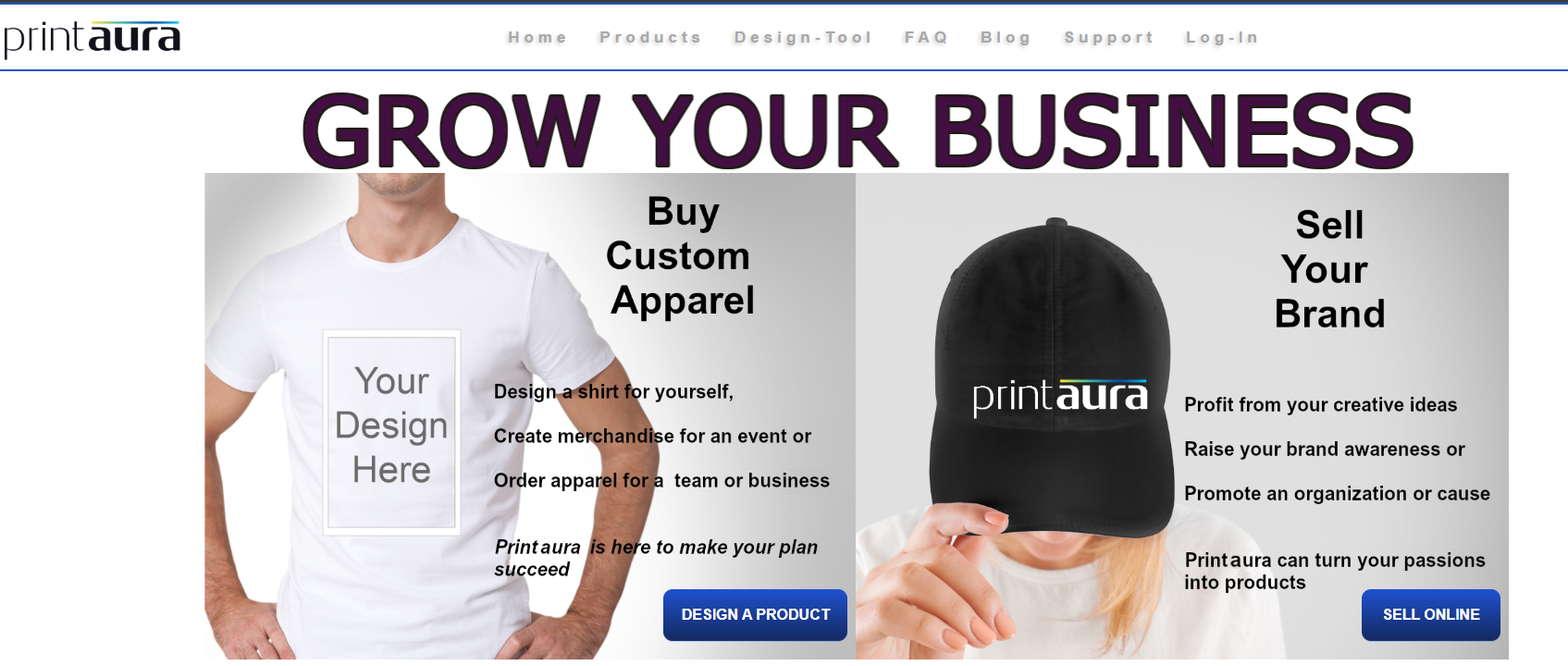
Print Aura is a print-on-demand fulfillment service that has been around for quite some time (based in the USA). It might not have the flashiest app or marketing, but Print Aura made a name by offering solid direct-to-garment printing on a wide range of apparel with no minimums. It’s essentially a classic POD drop shipper with a focus on clothing.
Features: Print Aura boasts over 100 different apparel styles (from basic tees to premium fashion tees, plus kids clothing, etc.), along with some accessories like phone cases and pillows. They operate as a white-label fulfillment partner – no Print Aura branding is seen by your customers. They integrate with Shopify and WooCommerce, and also allow manual order submissions for other platforms.
Why Consider Print Aura: If for some reason the bigger players don’t have a specific item you want, Print Aura might. They have some garment options that could differ (perhaps specific brands or cuts). They also handle all fulfillment in-house in the U.S. The user interface is not as modern as others, but Print Aura has a steady user base that likes the print quality and the personal service (it’s a smaller team, and sometimes you get more direct support). In the dodropshipping 2025 list, Print Aura was included as one of the top general POD companies – showing it’s still relevant.
That said, many features that newer apps have (like live mockup generators or fancy dashboards) may not be as polished in Print Aura. It’s a bit old-school. Think of it as a reliable print shop in the background. If you’re comfortable with the basics and just need a dependable apparel printer in the US, Print Aura can do the job. They also allow custom packing slips with your branding.
In summary, Print Aura is an option for those who want a straightforward POD supplier for apparel and don’t mind a simpler interface. It’s not usually the first pick for new sellers, but experienced ones sometimes stick with Print Aura for consistency once they dial in their product quality.
10. JetPrint – Best for Watches and Print-on-Demand Accessories
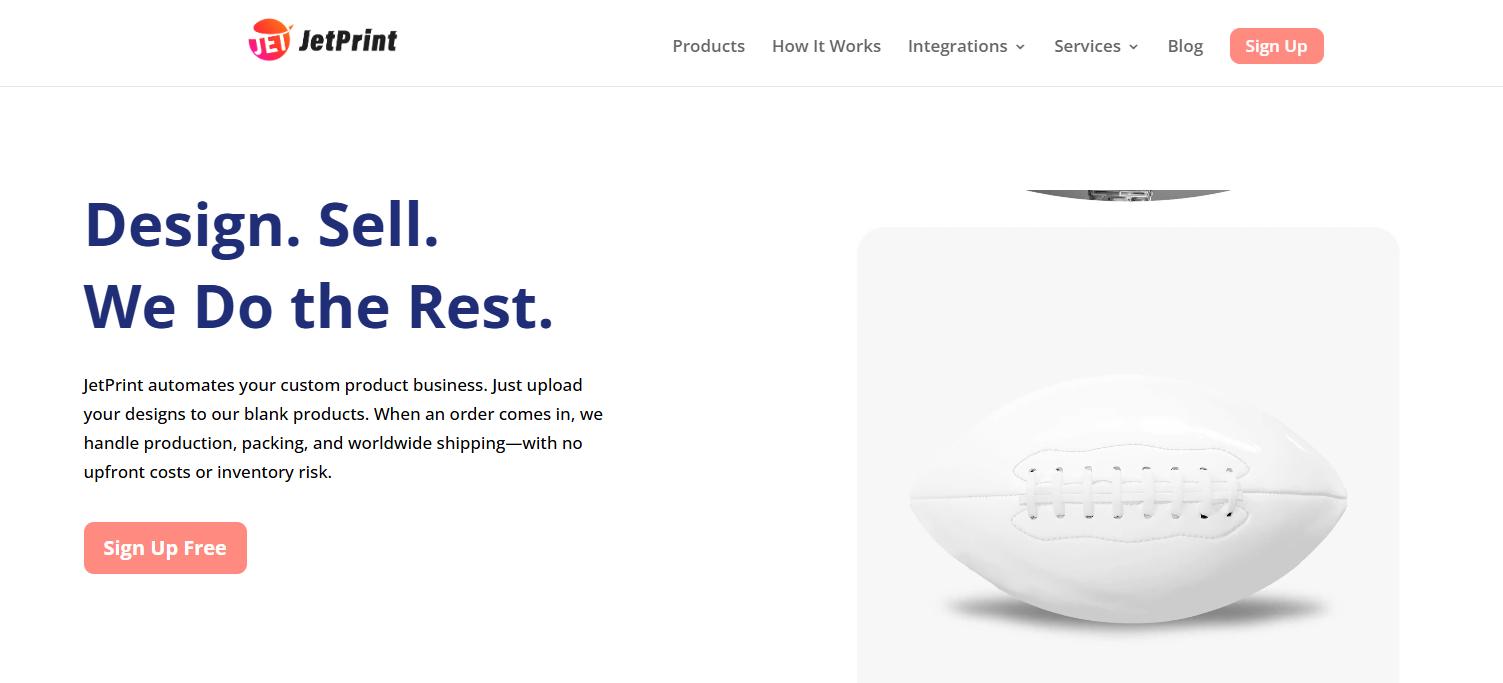
JetPrint is a relatively specialized print-on-demand company that initially made its mark by offering custom printed watches – a product very few others had. They have since expanded to other accessories like shoes, yoga mats, and home decor, but they are still often highlighted for their watch selection. Shopify’s list called JetPrint “Best for custom watches”.
Products: With JetPrint, you can create branded wrist watches featuring your own designs on the dial. They have various styles (leather strap, stainless steel, smart watch bands, etc.). In addition, JetPrint offers things like all-over-print sneakers, car seat covers, tapestries, and more unusual items. They also have some apparel, but the focus is on unique products.
Quality & Fulfillment: JetPrint’s watches have a surprisingly good quality for POD – sellers report that the print is clear and the watches function well for fashion purposes. Production takes a bit longer (a few days more) given the complexity, but they still fulfill in a reasonable time. JetPrint is based in China and most items ship from there, though they have made efforts to improve shipping speed with options like DHL. They advertise a 3-7 day production for watches and relatively fast shipping (one of their images shows global shipping in 3-15 days, which suggests they use expedited methods). Indeed, JetPrint emphasizes its fast global shipping for the niche products they offer.
Integration: They have a Shopify app that’s easy to use – for watches, they even provide templates to design the face. Creating products is straightforward.
Why Use JetPrint: If you want to offer something unique like custom watches, JetPrint is the go-to. It allows you to add a premium, higher-priced item to your store. For example, if you run a brand around your art or logo, selling a watch with that art could be a cool high-margin product. Also, JetPrint’s other items like shoes and mats can help broaden a product line. They might not replace your main POD provider for shirts, but they can supplement it with specialty goods. They’ve been improving their service over the years, and in 2025 they’re considered a reputable niche POD provider. In short, JetPrint is ideal for sellers who want to venture beyond standard products and offer custom accessories that stand out, backed by a dedicated service for those items.
11. ShineOn – Best for Print-on-Demand Jewelry
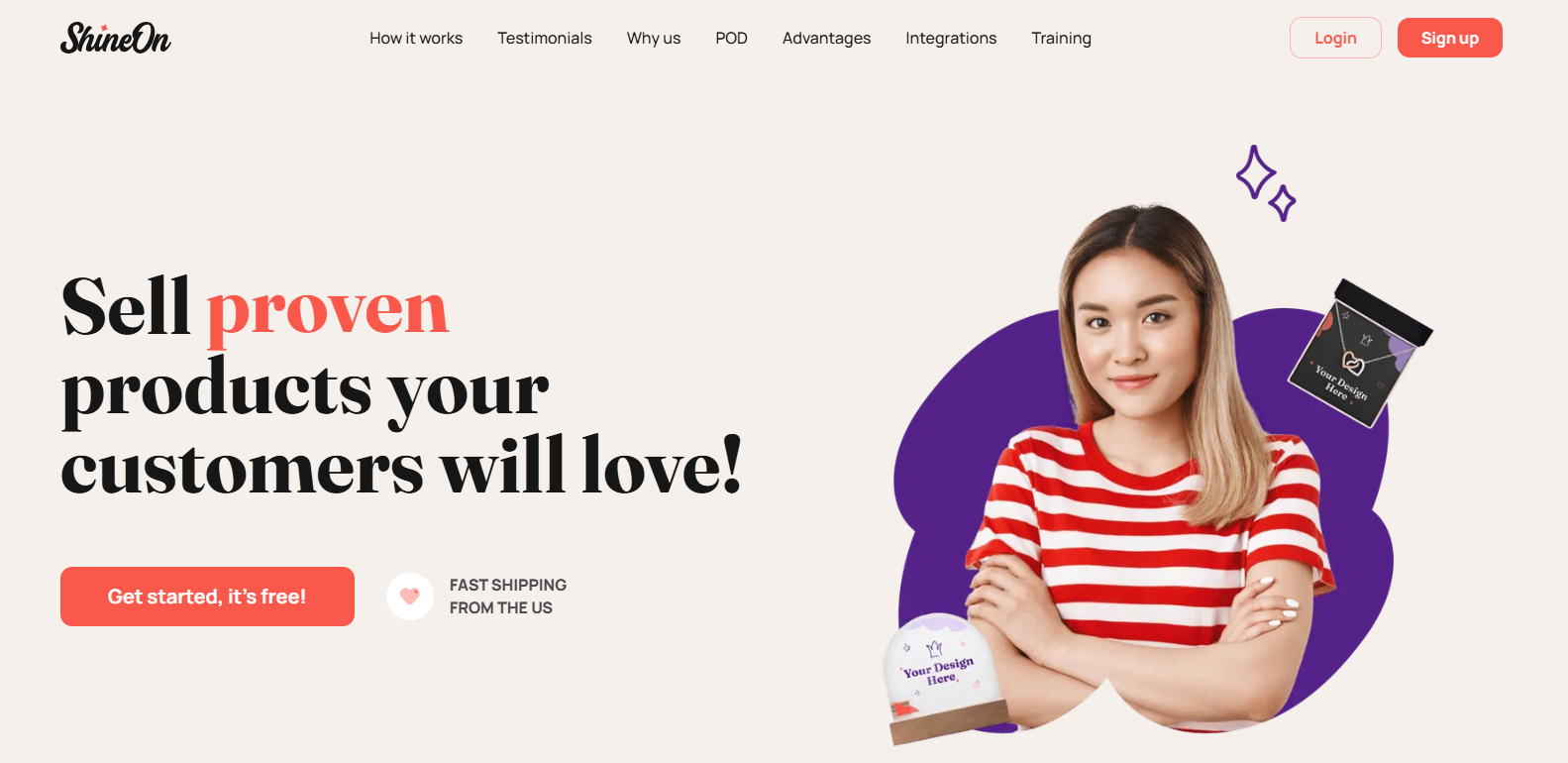
ShineOn is a leading print-on-demand supplier specifically for jewelry. If you’ve seen ads for those message-card necklaces or engraved gifts, ShineOn is likely involved. They focus on personalized jewelry pieces (necklaces, bracelets, watches, etc.) that can be customized with text or graphics and often come with a printed message card in the box. Shopify’s list noted ShineOn as “Best for custom jewelry”, and indeed ShineOn has enabled many entrepreneurs to sell jewelry without inventory.
What ShineOn Does: ShineOn’s flagship products are things like necklaces with pendants (e.g. hearts, crosses, dog tags) that come in a box with a customizable message card. Sellers can design a heartfelt or niche-specific message on the card, which really increases the perceived value (these are popular for gifts). ShineOn also offers engraved pieces where customers can engrave names or dates, and even watches with customized faces (though watches might now be through a partner integration). They continually release new jewelry styles – e.g., in 2025 they might have items like personalized birthstone necklaces or photo projection pendants.
Quality & Logistics: ShineOn manufactures the jewelry in the US (their facility is in Florida) and in some cases in Europe. The pieces are jewelry-grade metals (like stainless steel or sterling silver with gold finish options) – quality is good for the price point (these are fashion jewelry, usually selling from $40-$70 retail). They handle all printing of the message cards and assembly. Shipping is pretty fast in the US since it’s domestic. Sellers often praise ShineOn for enabling quick turnaround on gifts, especially around holidays like Christmas or Valentine’s Day.
Integration: ShineOn has a Shopify app. They also integrated with Etsy through a separate tool. The app allows you to create the designs for the message cards and product mockups easily. ShineOn also has a very active user community and training materials, which is a bonus if you’re new to selling jewelry.
Why Choose ShineOn: If you want to sell meaningful, high-margin gift products, ShineOn is fantastic. Jewelry has one of the highest perceived values among POD products, meaning you can charge a premium. For example, a necklace that costs you $10-$15 can often be sold for $50+ if the message card resonates emotionally with the buyer (e.g., a necklace gift from a mother to a daughter with a loving note). This can translate into strong profit margins. ShineOn is arguably the best in this particular space of jewelry POD – their platform is built for it, whereas general POD companies have only dabbled in jewelry. They also support seller success with lots of resources. Overall, ShineOn is a top POD company for anyone looking to enter the booming personalized jewelry market.
12. Printful – Best Overall POD Service

Printful is often regarded as the gold standard in print-on-demand. Founded in 2013 and based in the USA, Printful offers high-quality in-house production, a wide product catalog, and seamless integrations. It’s known for its reliability and strong focus on quality control. Printful’s range spans clothing (t-shirts, hoodies, leggings), accessories (hats, bags), home decor, and even sublimation products like all-over print apparel and embroidery. They print most products at their own facilities in the US, Mexico, Europe, etc., which helps maintain consistency.
Key Features: Printful has a user-friendly mockup generator and even additional services like graphic design assistance and video making for your products. They support adding branding to orders (custom labels, pack-ins) to give a fully branded experience. Printful integrates with a large variety of platforms (Shopify, Etsy, WooCommerce, Amazon, etc.), automating the entire process from order to shipment. They also offer 20% off sample orders so you can test products.
Shipping: Printful’s fulfillment is quick – most orders are printed in 2-5 days and 50% ship in under 3 days. With multiple fulfillment centers (USA, Canada, Europe, Japan, Australia), they can route orders to the nearest center for faster delivery. For example, a shirt order for a US customer might be printed in Charlotte, NC and arrive in just a few days. Domestic US shipping often starts around $3.99 for small items.
Why Choose Printful: If you value quality and dependability, Printful is a top choice. Shopify’s merchant reviews rate Printful 4.6 out of 5 with praise for product quality, consistency, and easy store syncing. Printful is great for scaling – whether you sell 10 items or 10,000, their infrastructure can handle it. The downside is that Printful’s base prices are a bit higher than some competitors (you pay for that in-house quality), which can mean slimmer margins unless you price your products at a premium. Nonetheless, for many sellers the peace of mind and brand reputation Printful provides is worth it. Overall, Printful is a robust, professional POD partner to grow with.
13. Redbubble – Best POD Marketplace for Artists
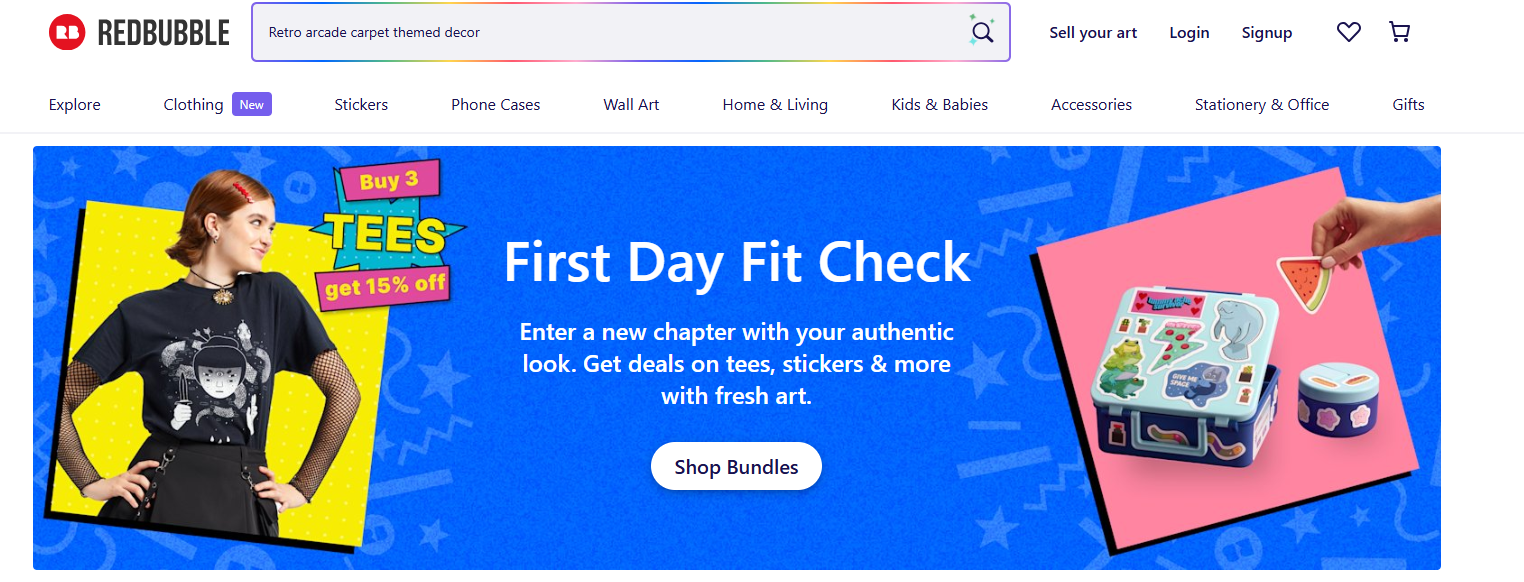
Not all print-on-demand businesses require you to have your own website. Redbubble is a popular print-on-demand marketplace where artists and designers can upload designs and have them printed on a variety of products for customers worldwide. It’s essentially a large marketplace (like Amazon or Etsy, but purely for print-on-demand goods). We include Redbubble in this list because it’s often cited as one of the top sites for POD, especially for creatives who want a hands-off selling experience.
How Redbubble Works: You create an account, upload your artwork, and choose which products to enable (Redbubble has shirts, stickers, phone cases, wall art, pillows, tote bags, and more). When customers browse Redbubble’s site and purchase something with your design, Redbubble handles the printing, shipping, and customer service. You earn a royalty on each sale (you can set your profit margin above the base price they require). It’s free to use; they make money by taking their base cost out of the selling price.
Advantages: Redbubble already has millions of visitors searching for cool designs – so it’s a way to get exposure without marketing your own site. They cover production in multiple regions (they have fulfillers in the US, EU, Australia, etc.), so customers typically get reasonably quick delivery. For an artist, this is a very low-effort way to monetize your art: upload once, sell on dozens of product types automatically. It’s also non-exclusive, so you could sell on Redbubble while also running your own POD store elsewhere.
Drawbacks: The main drawback is you’re in a competitive marketplace – you need to tag and optimize your designs to be found, and your store is on Redbubble’s domain (not building your own brand as much). The profit margins per item can be lower; typically artists might earn something like 20% by default (though you can adjust markup, too high and you might price out of the market). Also, you have less control over customer data since Redbubble handles everything.
Who Redbubble is Best For: Redbubble is great for hobbyist artists, graphic designers, or anyone who wants a passive side income from their designs without worrying about fulfillment. It’s also good as a testing ground for design ideas – you can see what sells. Some people use Redbubble to generate income to later fund their own independent store. It’s worth noting there are similar POD marketplaces, like Teepublic or Society6, but Redbubble is one of the largest and most established (since 2006). So, while not a traditional “supplier” for your own store, Redbubble earns a mention as a top POD platform for selling art on demand.
14. Zazzle – Best for Custom Gifts and Customer Personalization
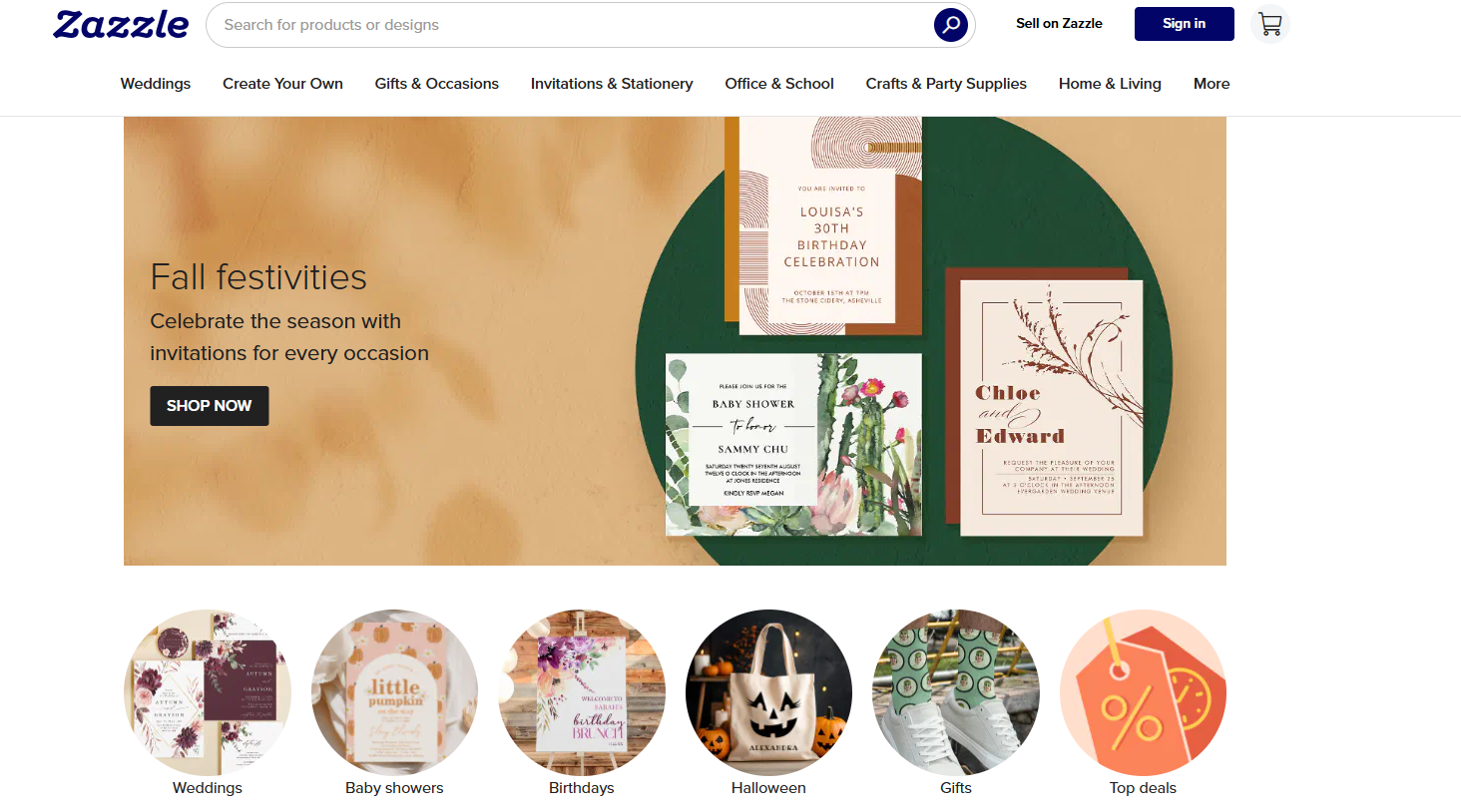
Zazzle is another major print-on-demand platform, but it combines a marketplace and a customization engine that allows end customers to personalize products. Zazzle has been around for a long time (since 2005) and is known for a wide range of customizable products – from business cards and invites to clothing and electronics cases.
How Zazzle Works: As a designer (or “Maker” in Zazzle terms), you can upload designs to products similar to Redbubble, earning royalties on sales through their marketplace. However, Zazzle also appeals to customers who want to customize templates – for instance, they might choose a wedding invitation design and edit the names/date themselves before ordering, or add their own photo to a mug template. Zazzle then prints and ships the item.
Products: Zazzle’s catalog is huge. They do a lot of print-on-paper (cards, posters) and have many novelty gift items. Some unique offerings include custom skateboards, embroidered hats, and even things like custom postage stamps (when that was allowed) or lamps. They also partner with brands for content (e.g., officially licensed designs people can customize).
Why Zazzle: It’s one of the best POD sites for personalized gifts – many people go to Zazzle to create one-off items for special occasions (think birthdays, weddings, corporate swag). For a designer, if you can create attractive templates that people customize, you can earn passive income. Zazzle handles all fulfillment similar to Redbubble. They also allow you to create a “storefront” on their platform if you want to direct people to your collection.
Note: Like Redbubble, the competition is high and you’re subject to their terms (they also moderate content strictly). But some artists do very well on Zazzle by focusing on lucrative niches (like wedding stationery or holiday-themed items). Zazzle often appears in “best POD websites” lists because of its longevity and reach. It’s the “design it yourself” destination for a lot of consumers.
In our context, Zazzle is highlighted as a top print-on-demand company particularly for those who want to tap into customer-driven customization demand. If you enjoy making templates for others to use (like a funny coffee mug where the user can insert their friend’s name), Zazzle is the place to be.
15. Lulu xPress – Best for Print-on-Demand Books
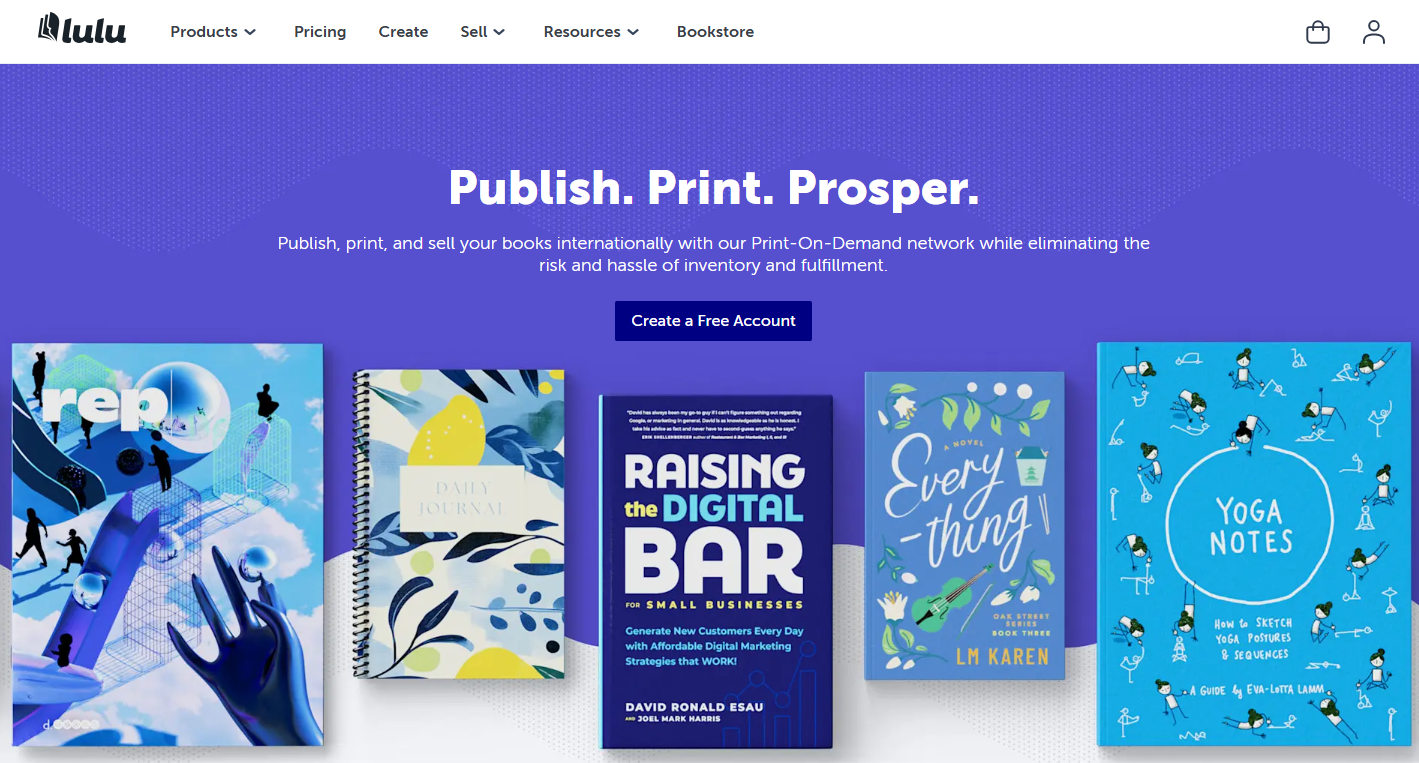
Rounding out our list is Lulu xPress (by Lulu), which is a leading print-on-demand service for books, comics, and calendars. Many POD providers focus on apparel, but Lulu specializes in publishing. If you’re an author or want to create printed content (like journals, planners, photo books), Lulu xPress is the go-to platform.
What Lulu Offers: Lulu has been known for self-publishing on demand for years. Their xPress service is essentially an integration-friendly version of their POD for ecommerce. They can print paperback and hardcover books in various sizes, comic books, magazines, yearbooks, calendars, etc. You can order one copy or many – truly on demand. Quality is bookstore-grade. They also can get your book an ISBN if you want to sell through traditional channels.
Integration: Lulu xPress provides a Shopify app to sell books on your own site, or you can use their site to order and fulfill. If you use their app, a customer’s order on your site triggers Lulu to print and ship the book directly to them, similar to how Printful would a shirt.
Why Lulu xPress: If your business or content lends itself to print media – be it a cookbook you wrote, a comic series, or a custom planner you designed – Lulu lets you sell it without investing in a print run upfront. This is huge for indie authors and small publishers. While Amazon’s KDP also prints books on demand, Lulu allows more flexibility in integration with your own store and product types (for example, KDP doesn’t do calendars or certain formats, but Lulu does).
For someone running a Shopify store, adding a related book or journal can be a great branding move (e.g., a fitness brand selling a workout logbook on demand). Lulu’s printing cost per unit depends on factors like page count, color vs. black & white, etc., but you set your retail price to ensure profit. The print quality is high – many use it to fulfill Kickstarter rewards or online shop orders for books.
Conclusion on Lulu: It’s a must-know POD supplier if publishing is part of your product lineup. They bring the print-on-demand model to a sector that historically was only bulk printing. With Lulu xPress on Shopify, even a small creator can sell professional books globally and print each one as orders come. That’s pretty powerful and worthy of being among the best POD companies of 2025 for those specific needs.
These 15 companies (and platforms) represent the cream of the crop in print-on-demand for 2025, each excelling in different areas. Whether you prioritize quality, variety, speed, global reach, or niche products, there’s a solution here for you. Many successful online stores actually use a combination of these POD providers to optimize their offerings – for example, using Printful for apparel, ShineOn for jewelry, and CJdropshipping for a mix of items.
When selecting from these, consider your business model and audience: Are you selling original art on a marketplace (Redbubble), building a fashion brand (Apliiq), targeting gift buyers (ShineOn/Zazzle), or just needing a reliable all-rounder (Printful/Printify/CJ)? Also weigh the user experience – if you’re new, something with great support and ease (like Printful or Printify) might be beneficial. If you’re experienced or ambitious, an integrated solution (like CJ or multiple apps) could maximize profit and flexibility.
Now that we’ve covered the top companies, let’s address a common question about profitability: which products give the best bang for your buck in print-on-demand?
Which Print-on-Demand Product Has the Highest Profit Margin?
When it comes to profit margins in print-on-demand, not all products are equal. Your margin – the difference between your selling price and the cost (product + printing + shipping) – can vary widely by product type. Generally, high-margin products are those that consumers are willing to pay a premium for, while having relatively low production costs. Based on industry data and trends going into 2025, here are some of the print-on-demand products known for higher profit potential:
-
All-Over-Print Apparel: Custom all-over-print clothing (such as full-print t-shirts, hoodies, yoga leggings with vibrant patterns) is cited as one of the most profitable POD niches. Because these items are more unique and eye-catching, customers often pay more for them. For example, an all-over-print shirt might retail for $30-$40 whereas a normal printed tee goes for $20-$25. Despite a slightly higher base cost, the markup can be significant. In fact, sellers can achieve over 50% profit margins on all-over-print tees. Merchize (a POD platform) notes that premium all-over-print polos have seen 60%+ profit margins per sale, and all-over-print Hawaiian shirts can reach around 65% profit in some cases due to their perceived value and novelty.
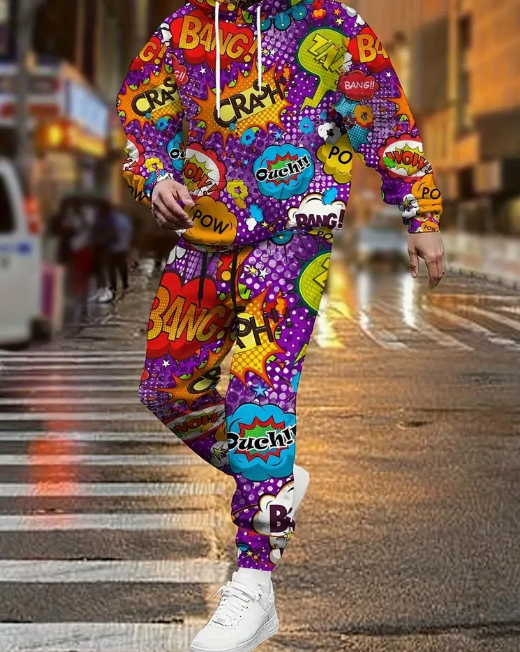
-
Print-On-Demand Jewelry: Jewelry items, especially those with personalization (names, engravings, message cards as with ShineOn), often have excellent margins. The base cost of a necklace might be $10, and it’s not uncommon to sell it for $49.99, especially when marketed as a heartfelt gift. That’s roughly a 5x markup. Even after factoring shipping and any platform fees, you could be looking at well above 60-70% margin in dollar terms. Consumers value the emotional aspect and gift-ready packaging, allowing higher pricing.

-
Home Decor & Art Prints: Wall art (canvas prints, posters) and home decor like throw pillows or blankets can also have healthy margins. A canvas print might cost you $15-$20 to fulfill but can be sold for $60+ if positioned as high-quality art. Likewise, custom printed blankets or curtains are unique finds that people pay a premium for, especially with personalized designs or limited availability.
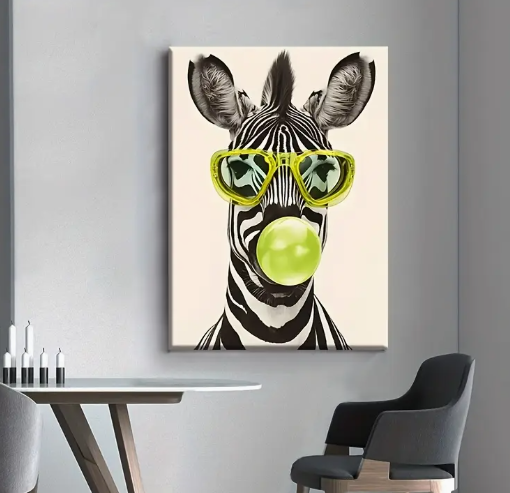
-
Accessories and Niche Items: Certain accessories – for instance, custom phone cases or engraved watches – have a relatively low unit cost but can be priced based on perceived value. A phone case might cost $6 to produce; consumers often pay $20-$30 for a cool design (thus ~70-80% margins). Custom watches, as mentioned with JetPrint, might cost $15-$20 and could sell for $50-$80 depending on quality, also yielding solid margins if you find the right audience.
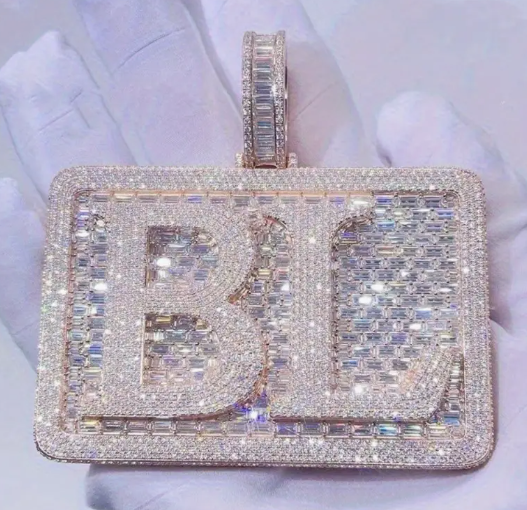
-
Printables with Low Cost: Items like stickers or art prints on paper have very low production costs (cents to a couple dollars) and while they sell for lower prices, the percentage margin can be high. For example, a sticker might cost $1 and you sell it for $3 – that’s a 66% margin. On a larger scale, if you incorporate such items in bundles or upsells, they boost overall profitability.
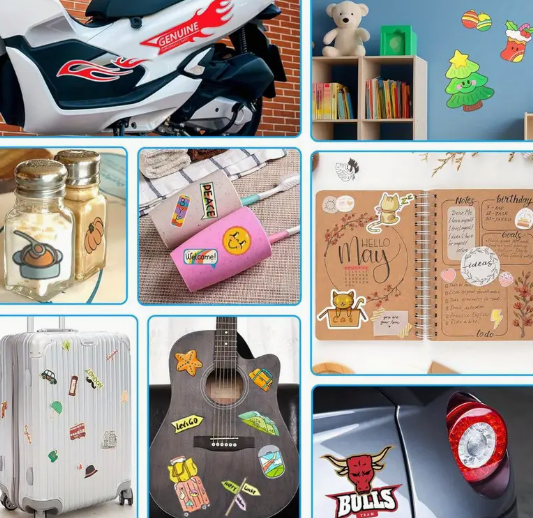
It’s important to note that profit margin percentage isn’t everything – you also want to consider absolute profit (in dollars) and sales volume. For instance, apparel might have a 40% margin which is standard, and while that’s lower than some categories, apparel sells in high volume and can still be very profitable. According to a pricing strategy guide, “apparel typically achieves a 40% margin, while products like candles can reach up to 60%”. So a variety of products can be lucrative.
If the question is asking for the single highest margin product, one could argue that custom digital products (like instant download printables) would be nearly 100% profit after the first sale, but focusing on physical POD: items like greeting cards or calendars might have extremely high markups (a greeting card might cost $0.50 to print and sell for $5 – that’s 90% margin). However, as a general category, all-over-print clothing consistently comes up as a top high-margin area. Printful notes that all-over-print items are unique and allow you to charge more, and many POD entrepreneurs have gravitated to them for this reason.
To directly answer: All-over-print apparel (e.g. AOP shirts, hoodies, leggings) is often pointed to as having some of the highest profit margins in POD, with sellers commonly seeing margins of 50-60% or more. This is because of their uniqueness and the premium customers are willing to pay. Additionally, high-value gift items like custom jewelry also yield very high margins per sale, sometimes north of 60% as well, due to emotional value.
Ultimately, the highest margin is achieved when you create perceived value – through unique design, personalization, branding, or bundling. Choose products that align with a passionate niche or use-case (willing to spend more) and where the base cost is low enough. For many POD sellers in 2025, the sweet spot has been thinking outside the basic t-shirt – leveraging things like all-over-prints, jewelry, premium decor, etc., to enjoy both healthy profits and differentiation in the market.
Best Print-on-Demand App for Your Shopify Store
If you’re running a Shopify store, you might wonder which POD app will serve you best. The answer can vary depending on your needs, but let’s break it down to a few top contenders and an overall recommendation:
-
Printful: Widely considered one of the best Shopify POD apps due to its one-click integration, reliability, and quality. It has over 2,200 reviews on the Shopify App Store with a 4.6/5 rating, with merchants praising its seamless syncing, product quality, and support. The app interface is smooth, allowing you to create and publish products easily. Printful automates order fulfillment and provides live shipping rates. If you want a trouble-free experience and plan to scale, Printful is a top choice. It’s often recommended for beginners and pros alike who want an all-around excellent service.
-
Printify: Another excellent Shopify app, especially if cost is a concern and you want variety. Printify’s app lets you choose your print provider and shows their pricing and ratings. It has a slightly higher rating at 4.7/5 with 2,400+ reviews, with users highlighting its ease of use and how it helped them get started quickly. Printify is great for merchants who want flexibility and lower base prices (especially with Printify Premium for Shopify sellers doing volume). Its drawback is occasionally needing to switch providers if one has issues, but the app makes that manageable. For a budget-conscious Shopify seller looking for both range and simplicity, Printify is an awesome app.
-
CJdropshipping: CJ’s Shopify app is powerful if you intend to use their broader dropshipping features in addition to POD. The app enables product importing and has automation for order processing. The appeal is having a single app to access both POD products and non-POD inventory from CJ’s catalog. For example, you can design a POD mug and also list a non-custom kitchen gadget, all fulfilled by CJ. The app might be a bit more complex than Printful’s due to the breadth of features, but it’s very capable. If you’re running a hybrid store or want to streamline multiple sourcing needs, the CJdropshipping app could be the best fit.

-
Others: There are other notable Shopify POD apps like Gelato (great for international focus), SPOD (fast production, simple integration), TeeLaunch, Gooten, etc. Each has its app with varying interface and features. Gelato’s app, for instance, is praised for easily routing orders globally. Gooten’s app caters well to those with higher order volumes or multiple stores.
Overall Best App: If we have to pick one, Printful’s Shopify app gets the crown for being the best all-around print-on-demand app for Shopify in 2025. It’s extremely user-friendly for newcomers yet robust enough for large shops, offers a wide product selection, and is very reliable. Printful handles everything from product mockups to automatically pushing tracking to your Shopify orders. Merchants often mention that using Printful’s app feels almost native to Shopify because it’s so well integrated – from product creation to fulfillment notifications.
That said, the “best” really depends on your priorities. Some merchants might find Printify better if cost and variety trump other factors, or CJdropshipping best if they want one solution for all products.
One approach is to install a couple of these apps and test them – many merchants use multiple POD apps concurrently (e.g., Printful for some products, another for others). This is totally doable on Shopify and gives you the strengths of each.
But if you want to start with a single, tried-and-true solution, you can’t go wrong with Printful’s app for Shopify – it’s highly rated, extensively documented, and supported by an experienced team. It will cover your bases with quality, features, and ease of use, allowing you to focus on design and marketing rather than worrying about fulfillment hiccups.
How Print-on-Demand Fits Into Dropshipping (POD in Action)
(You might wonder how print-on-demand works as a business model in practice, or hear the term “dropshipping” used in tandem. Let’s quickly clarify this to round out our discussion.)
Print-on-demand is essentially a form of dropshipping. In traditional dropshipping, you list products from a supplier on your store, and when you get a sale, the supplier ships the product to your customer. You never touch inventory. POD is the same mechanism – except you are also adding a customization (the print) to the product before it ships. So POD can be seen as “dropshipping with your custom design on the product.”
Why mention this? Because many entrepreneurs successfully build their business by combining standard dropshipping items with print-on-demand items. For example, you could run a pet-themed store where you dropship pet toys and accessories from suppliers, and also sell print-on-demand pet T-shirts or mugs that you design. The integration of POD and dropshipping gives you greater control over branding (via POD products) while still offering variety (via dropshipped catalog products). Platforms like CJdropshipping, as we covered, facilitate both under one roof.
It’s also worth noting that POD eliminates some challenges of traditional dropshipping – notably, differentiation. In plain dropshipping, many stores might sell the exact same products from AliExpress or similar sources, leading to price competition. With print-on-demand, your products are unique because they carry your design or message. This uniqueness builds brand value and can foster customer loyalty (they can’t get your cool “Space Cat” graphic tee anywhere else but your store, for instance).
From a customer’s perspective, a well-run POD dropshipping store is seamless: they order, and a week later a custom item arrives, indistinguishable from any retail product. As the seller, you didn’t invest in inventory or equipment – you leveraged technology and supplier networks to make it happen. That’s pretty amazing when you think about it.
Real-world example: Let’s say you design a funny slogan shirt – “Coffee Before Talkie” – and list it for $25. A customer finds it via your Facebook ad and orders. Your integrated POD app (e.g., Printful) automatically prints that shirt at one of its facilities and ships it to the customer with your label on it. You, meanwhile, paid maybe $12 for the printing and shipping. You made $13 profit without touching the product. That’s POD in action – a form of automated entrepreneurship that can scale as you add more designs or target more niches.
It’s not entirely hands-off, of course. Success requires market research, great designs, marketing effort, and customer service. Some designs will flop, some will be hits. But the low overhead means you can afford to test many ideas. As one Shopify article put it, print-on-demand “makes running a business more accessible” by outsourcing manufacturing. This is why we’re seeing a surge of creative online brands, from one-person startups to influencer merch lines, all leveraging POD.
So if you’re considering starting a print-on-demand business in 2025, you’re tapping into a proven model with ever-improving infrastructure. Choose your platform, sync it to your store, upload those designs, and you’re in business – potentially a global business from day one.
To wrap up, let’s answer a few frequently asked questions about print-on-demand companies that you might still be curious about:
Print-on-Demand Companies FAQ
Q1: Are print-on-demand companies free to use?
Yes – most POD platforms are free to join and you only pay when an order is made (covering the product base cost and shipping). There are typically no upfront fees or subscriptions required to start using services like Printful, Printify, or CJdropshipping. (Some offer premium plans for discounts, but basic use is free.)
Q2: Is print-on-demand still profitable in 2025?
Absolutely. While margins can be slimmer than producing in bulk, POD sellers often aim for around a 40-50% profit margin on products. By choosing high-margin products (e.g. all-over-print apparel or custom jewelry) and pricing strategically, you can run a profitable business. Success comes from great designs, effective marketing, and optimizing costs – many entrepreneurs are scaling profitable POD brands right now.
Q3: Which print-on-demand company is the best?
There isn’t a one-size-fits-all answer – the “best” depends on your needs. CJdropshipping is often praised as the best overall for quality and ease. CJdropshipping is best for variety and competitive pricing.
Q4: How long do print-on-demand orders take to ship?
On average, expect a few days for production and then shipping time on top. Many providers fulfill within 2-5 days. Shipping varies by destination – domestic orders can often arrive within a week (some providers like CJdropshipping or Printful’s US/EU facilities ship in just 3-5 days). International shipping might take 1-2 weeks unless local production is used. Some companies (e.g., SPOD, Printful) pride themselves on very quick turnaround. Always communicate estimated delivery times to customers (typically 1-2 weeks as a safe window for standard POD delivery).
Final Thoughts: Print-on-demand companies have lowered the barriers to entry for launching custom products to near zero. With a bit of creativity and the right partner, you can turn your ideas into products and reach customers around the world. The best POD company for you will be the one that aligns with your vision – be it a premium fashion line, a global fanbase, or a trending niche store. Hopefully, this guide gave you the insight needed to make that choice and get started (or scale up) confidently. Happy printing and much success with your on-demand venture in 2025!
